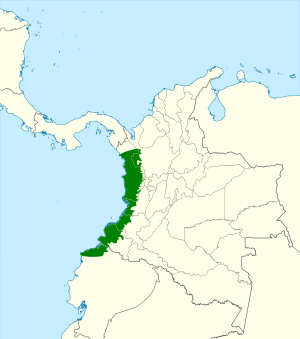Chocó woodpecker facts for kids
Quick facts for kids Chocó woodpecker |
|
|---|---|
| Conservation status | |
| Scientific classification | |
| Genus: |
Veniliornis
|
| Species: |
chocoensis
|
 |
|
| Synonyms | |
|
Dryobates chocoensis |
|
The Choco woodpecker (Veniliornis chocoensis) is a special bird found in the forests of Colombia and Ecuador. It's a type of woodpecker, which means it's part of the Picidae family. This bird is currently listed as Near Threatened, meaning it could become endangered if we don't protect its home.
Contents
About the Choco Woodpecker
How Scientists Classify It
Scientists like to group living things to understand them better. The Choco woodpecker is usually placed in a group called Veniliornis. However, some scientists have recently moved it to a different group called Dryobates. No matter the group, everyone agrees on its English name: Choco woodpecker.
For a long time, some people thought the Choco woodpecker was just a type of golden-collared woodpecker or red-stained woodpecker. But now, most experts agree it's its own unique species. This means it's a one-of-a-kind bird!
What It Looks Like
The Choco woodpecker is a small bird, about 15 to 16 centimeters (6 inches) long. It weighs around 30 grams (1 ounce), which is about the same as a few coins.
Males and females look very similar, except for their heads. Males have a bright red cap on their heads. Females have a dark olive-brown cap instead. Both have brownish-yellow faces with some darker stripes. The back of their neck is a dull golden color.
Their bodies are mostly a shiny golden-green, with some reddish hints. They have pale yellow stripes and olive-yellow bars on their lower back. Their wings are dark brown with yellow edges and stripes. Their tail is dark brown with yellow bars. Their belly has stripes of olive and whitish-yellow.
Their eyes are reddish-brown, and their beak is dark with a lighter lower part. Their legs are dark olive. Young Choco woodpeckers look a lot like the adults, but their faces have more stripes. Both young males and females have some red on their heads, with males having more.
Where It Lives
The Choco woodpecker lives in a special area called the Chocó Biogeographic Region. This region stretches from northern Colombia down to Ecuador.
It prefers to live inside and around the edges of very wet forests. You can find it at elevations up to 1,000 meters (3,300 feet), but it usually stays below 700 meters (2,300 feet).
Choco Woodpecker Behavior
Staying in One Place
Scientists believe the Choco woodpecker stays in the same area all year round. It doesn't migrate to different places.
What It Eats
We don't know much about what the Choco woodpecker eats. However, a pair of these birds was once seen looking for food with a group of different bird species. This is called a mixed species foraging flock. It's thought that their diet is similar to the red-stained woodpecker, which mainly eats insects found in trees.
How It Raises Young
Unfortunately, almost nothing is known about how the Choco woodpecker breeds. Scientists haven't yet discovered details about their nests, eggs, or how they raise their chicks.
What It Sounds Like
The Choco woodpecker makes several different sounds. It can make sharp pik notes, softer quip notes, and even wicka-wicka sounds. It also has a gentle rattling call.
Protecting the Choco Woodpecker
The IUCN (International Union for Conservation of Nature) has listed the Choco woodpecker as "Near Threatened." This means its population is not huge, and it's believed to be shrinking.
Its forest home is facing threats from people cutting down trees for wood and farms. Mining and growing certain crops also harm its habitat. The loss of its forest home is a big problem, especially in the areas where it lives.
The Choco woodpecker seems to be rare, even in its small home range. However, it does live in a few protected areas, which helps keep it safe. To make sure this species doesn't become "Vulnerable" or endangered, we need to protect its forest homes.
See also
 In Spanish: Carpintero del Chocó para niños
In Spanish: Carpintero del Chocó para niños 


